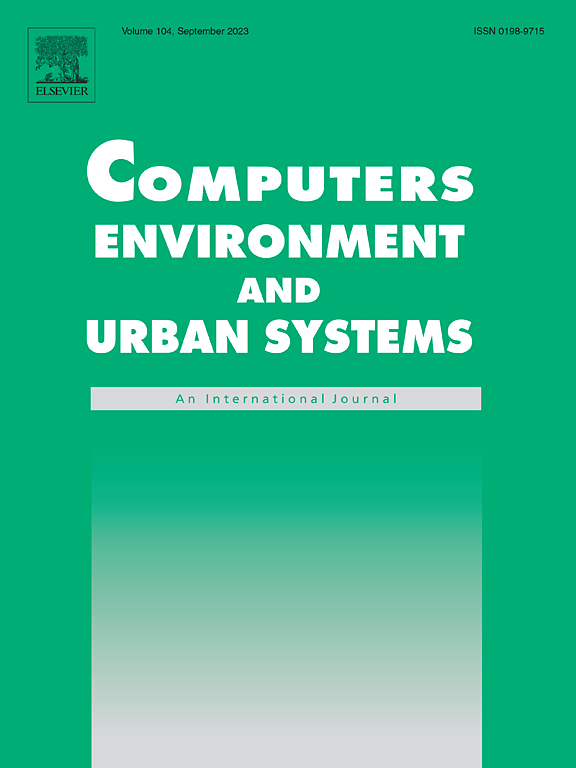Machine-based understanding of noise perception in urban environments using mobility-based sensing data
IF 8.3
1区 地球科学
Q1 ENVIRONMENTAL STUDIES
Computers Environment and Urban Systems
Pub Date : 2024-10-30
DOI:10.1016/j.compenvurbsys.2024.102204
引用次数: 0
Abstract
An accurate understanding of noise perception is important for urban planning, noise management and public health. However, the visual and acoustic urban landscapes are intrinsically linked: the intricate interplay between what we see and hear shapes noise perception in the urban environment. To measure this complex and mixed effect, we conducted a mobility-based survey in Hong Kong with 800 participants, recording their noise exposure, noise perception and GPS trajectories. In addition, we acquired Google Street View images associated with each GPS trajectory point and extracted the urban visual environment from them. This study used a multi-sensory framework combined with XGBoost and Shapley additive interpretation (SHAP) models to construct an interpretable classification model for noise perception. Compared to relying solely on sound pressure levels, our model exhibited significant improvements in predicting noise perception, achieving a six-classification accuracy of approximately 0.75. Our findings revealed that the most influential factors affecting noise perception are the sound pressure levels and the proportion of buildings, plants, sky, and light intensity. Further, we discovered non-linear relationships between visual factors and noise perception: an excessive number of buildings exacerbated noise annoyance and stress levels and diminished objective noise perception at the same time. On the other hand, the presence of green plants mitigated the effect of noise on stress levels, but beyond a certain threshold, it led to worsened objective noise perception and noise annoyance instead. Our study provides insight into the objective and subjective perception of noise pressure, which contributes to advancing our understanding of complex and dynamic urban environments.

利用基于移动性的传感数据,基于机器理解城市环境中的噪声感知
准确了解噪声感知对于城市规划、噪声管理和公众健康非常重要。然而,城市的视觉和听觉景观之间存在着内在联系:我们的所见所闻之间错综复杂的相互作用形成了对城市环境噪声的感知。为了测量这种复杂的混合效应,我们在香港进行了一项以流动性为基础的调查,有 800 人参加,记录了他们的噪声暴露、噪声感知和 GPS 轨迹。此外,我们还获取了与每个 GPS 轨迹点相关的谷歌街景图片,并从中提取了城市视觉环境。本研究采用多感官框架,结合 XGBoost 和 Shapley 加法解释(SHAP)模型,构建了一个可解释的噪声感知分类模型。与单纯依赖声压级相比,我们的模型在预测噪声感知方面有显著改善,六级分类准确率约为 0.75。我们的研究结果表明,影响噪声感知的最大因素是声压级以及建筑物、植物、天空和光照强度的比例。此外,我们还发现了视觉因素与噪声感知之间的非线性关系:过多的建筑物会加剧噪声烦恼和压力水平,同时降低客观噪声感知。另一方面,绿色植物的存在减轻了噪声对压力水平的影响,但超过一定临界值后,反而会导致客观噪声感和噪声烦扰度的恶化。我们的研究有助于深入了解人们对噪声压力的客观和主观感受,从而加深我们对复杂多变的城市环境的理解。
本文章由计算机程序翻译,如有差异,请以英文原文为准。
求助全文
约1分钟内获得全文
求助全文
来源期刊

Computers Environment and Urban Systems
Multiple-
CiteScore
13.30
自引率
7.40%
发文量
111
审稿时长
32 days
期刊介绍:
Computers, Environment and Urban Systemsis an interdisciplinary journal publishing cutting-edge and innovative computer-based research on environmental and urban systems, that privileges the geospatial perspective. The journal welcomes original high quality scholarship of a theoretical, applied or technological nature, and provides a stimulating presentation of perspectives, research developments, overviews of important new technologies and uses of major computational, information-based, and visualization innovations. Applied and theoretical contributions demonstrate the scope of computer-based analysis fostering a better understanding of environmental and urban systems, their spatial scope and their dynamics.
 求助内容:
求助内容: 应助结果提醒方式:
应助结果提醒方式:


